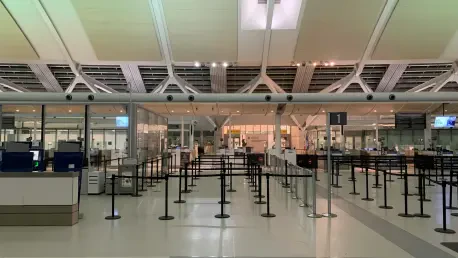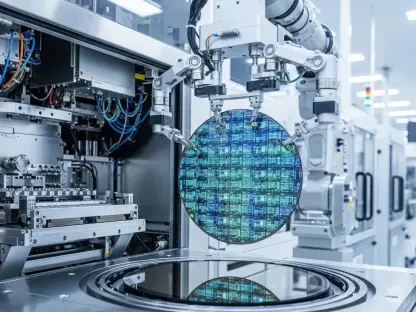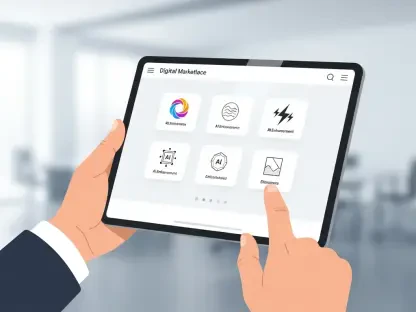Imagine stepping into a bustling airport, rushing to catch a flight, and breezing through security with just a quick scan of your face—no fumbling for passports or enduring long queues. This is the promise of facial recognition technology, now operational in 15 major US airports through the TSA PreCheck touchless lanes. Deployed by the Department of Homeland Security (DHS) in partnership with the Transportation Security Administration (TSA), this system aims to revolutionize air travel by prioritizing speed and efficiency. Yet, beneath the allure of convenience lies a growing unease about personal privacy and the security of biometric data. As this technology becomes more widespread, a critical debate emerges, pitting the benefits of streamlined travel against the potential erosion of individual rights. This complex issue demands a closer look at how such advancements are reshaping airport security and what they mean for travelers today.
The Rise of Touchless Security Systems
Efficiency Gains in Modern Travel
Facial recognition technology has been integrated into security processes at key airports like Chicago O’Hare, Dallas/Fort Worth, and Los Angeles International (LAX), targeting travelers enrolled in TSA PreCheck with a valid Known Traveler Number or those tied to airline loyalty programs. The system allows eligible passengers to skip traditional passport checks by having their faces scanned, ushering them swiftly toward luggage screening. Proponents, including TSA officials, argue that this innovation significantly cuts down wait times, creating a smoother experience for frequent flyers. The appeal is undeniable—airports are often synonymous with stress and delays, and any solution that promises a faster journey garners attention. However, the current efficiency of touchless lanes may be tied to their limited usage, raising questions about scalability. If adoption increases, the system’s ability to maintain such speed without technical hiccups or maintenance challenges remains untested, casting doubt on long-term reliability.
Industry Push for Adoption
Airlines and industry groups, such as Airlines for America representing major carriers like United and Delta, strongly advocate for the widespread use of facial recognition, emphasizing its role in preventing bottlenecks at security checkpoints. Their stance is clear: restricting this technology could lead to longer lines and frustrated passengers, ultimately harming the travel experience. Beyond convenience, some argue that such systems enhance security by providing a more accurate means of identity verification compared to manual checks. Yet, this push for adoption often overlooks the concerns of those who see the technology as a double-edged sword. While airlines focus on operational benefits, the conversation around data protection remains secondary in their narrative. This tension between industry priorities and passenger apprehensions highlights a broader divide, as the drive for efficiency sometimes appears to overshadow the need for robust safeguards against potential misuse of personal information.
Balancing Convenience with Privacy Concerns
Risks of Biometric Data Exposure
The adoption of facial recognition at airports introduces significant privacy risks, particularly around the storage and security of biometric data. Critics point to past incidents, such as a 2019 data breach involving a DHS subcontractor where travelers’ photos were compromised, as evidence of the vulnerabilities inherent in these systems. Despite assurances from the TSA that databases are encrypted and information is protected, public skepticism persists. The fear of data breaches is not unfounded, as biometric information, unlike a password, cannot be changed once stolen. This raises profound concerns about identity theft and unauthorized surveillance. For travelers, the decision to opt into touchless lanes becomes a gamble—trading personal data for speed, with no guarantee of absolute safety. As this technology expands, ensuring airtight security measures will be paramount to maintaining public trust in an era where digital threats are ever-evolving.
Voices of Opposition and Legislative Pushback
Privacy advocates and lawmakers from across the political spectrum have voiced strong opposition to the unchecked use of facial recognition in airports, warning of a potential slide into a surveillance state. A bipartisan coalition, including figures like Republican Senator John Kennedy and Democratic Senator Jeff Merkley, has criticized the TSA for what they see as excessive screening practices. Proposed legislation in the Senate seeks to limit the scope of facial scans, mandating that data be used solely for identity verification and deleted immediately after, while also ensuring passengers are clearly informed of their right to refuse. Internal disagreements within government agencies further complicate the issue, as differing views between DHS leadership and TSA officials reveal a lack of consensus on how to proceed. This legislative pushback underscores a fundamental concern: without strict oversight, the technology risks becoming a tool for overreach, prioritizing security at the expense of civil liberties.
Options for Travelers and Future Implications
Amid the debate, travelers retain the option to opt out of facial recognition and request a manual ID check, offering a temporary compromise for those uneasy about submitting biometric data. This choice, however, may become less viable if touchless systems become the norm, potentially pressuring passengers to comply for the sake of convenience. Looking ahead, the future of this technology hinges on regulatory decisions currently under discussion in Congress. Striking a balance between innovation and individual rights will be crucial, as will addressing technical limitations that could emerge with wider implementation. For now, the lack of agreement among stakeholders—airlines, privacy advocates, and government bodies—leaves the path forward uncertain. As these discussions unfold, it becomes evident that resolving these tensions demands not just policy changes but a broader societal reckoning with the value placed on privacy versus efficiency in public spaces like airports.









